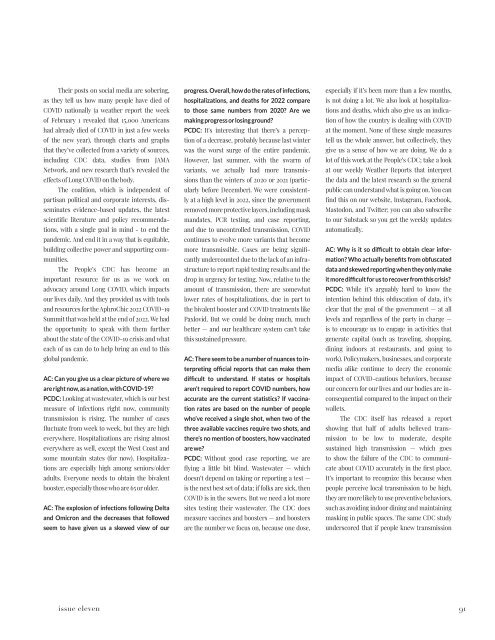AphroChic Magazine: Issue No. 11
Create successful ePaper yourself
Turn your PDF publications into a flip-book with our unique Google optimized e-Paper software.
Their posts on social media are sobering,<br />
as they tell us how many people have died of<br />
COVID nationally (a weather report the week<br />
of February 1 revealed that 15,000 Americans<br />
had already died of COVID in just a few weeks<br />
of the new year), through charts and graphs<br />
that they’ve collected from a variety of sources,<br />
including CDC data, studies from JAMA<br />
Network, and new research that’s revealed the<br />
effects of Long COVID on the body.<br />
The coalition, which is independent of<br />
partisan political and corporate interests, disseminates<br />
evidence-based updates, the latest<br />
scientific literature and policy recommendations,<br />
with a single goal in mind - to end the<br />
pandemic. And end it in a way that is equitable,<br />
building collective power and supporting communities.<br />
The People’s CDC has become an<br />
important resource for us as we work on<br />
advocacy around Long COVID, which impacts<br />
our lives daily. And they provided us with tools<br />
and resources for the <strong>AphroChic</strong> 2022 COVID-19<br />
Summit that was held at the end of 2022. We had<br />
the opportunity to speak with them further<br />
about the state of the COVID-19 crisis and what<br />
each of us can do to help bring an end to this<br />
global pandemic.<br />
AC: Can you give us a clear picture of where we<br />
are right now, as a nation, with COVID-19?<br />
PCDC: Looking at wastewater, which is our best<br />
measure of infections right now, community<br />
transmission is rising. The number of cases<br />
fluctuate from week to week, but they are high<br />
everywhere. Hospitalizations are rising almost<br />
everywhere as well, except the West Coast and<br />
some mountain states (for now). Hospitalizations<br />
are especially high among seniors/older<br />
adults. Everyone needs to obtain the bivalent<br />
booster, especially those who are 65 or older.<br />
AC: The explosion of infections following Delta<br />
and Omicron and the decreases that followed<br />
seem to have given us a skewed view of our<br />
progress. Overall, how do the rates of infections,<br />
hospitalizations, and deaths for 2022 compare<br />
to those same numbers from 2020? Are we<br />
making progress or losing ground?<br />
PCDC: It's interesting that there’s a perception<br />
of a decrease, probably because last winter<br />
was the worst surge of the entire pandemic.<br />
However, last summer, with the swarm of<br />
variants, we actually had more transmissions<br />
than the winters of 2020 or 2021 (particularly<br />
before December). We were consistently<br />
at a high level in 2022, since the government<br />
removed more protective layers, including mask<br />
mandates, PCR testing, and case reporting,<br />
and due to uncontrolled transmission, COVID<br />
continues to evolve more variants that become<br />
more transmissible. Cases are being significantly<br />
undercounted due to the lack of an infrastructure<br />
to report rapid testing results and the<br />
drop in urgency for testing. <strong>No</strong>w, relative to the<br />
amount of transmission, there are somewhat<br />
lower rates of hospitalizations, due in part to<br />
the bivalent booster and COVID treatments like<br />
Paxlovid. But we could be doing much, much<br />
better — and our healthcare system can’t take<br />
this sustained pressure.<br />
AC: There seem to be a number of nuances to interpreting<br />
official reports that can make them<br />
difficult to understand. If states or hospitals<br />
aren’t required to report COVID numbers, how<br />
accurate are the current statistics? If vaccination<br />
rates are based on the number of people<br />
who’ve received a single shot, when two of the<br />
three available vaccines require two shots, and<br />
there’s no mention of boosters, how vaccinated<br />
are we?<br />
PCDC: Without good case reporting, we are<br />
flying a little bit blind. Wastewater — which<br />
doesn’t depend on taking or reporting a test —<br />
is the next best set of data; if folks are sick, then<br />
COVID is in the sewers. But we need a lot more<br />
sites testing their wastewater. The CDC does<br />
measure vaccines and boosters — and boosters<br />
are the number we focus on, because one dose,<br />
especially if it’s been more than a few months,<br />
is not doing a lot. We also look at hospitalizations<br />
and deaths, which also give us an indication<br />
of how the country is dealing with COVID<br />
at the moment. <strong>No</strong>ne of these single measures<br />
tell us the whole answer, but collectively, they<br />
give us a sense of how we are doing. We do a<br />
lot of this work at the People’s CDC; take a look<br />
at our weekly Weather Reports that interpret<br />
the data and the latest research so the general<br />
public can understand what is going on. You can<br />
find this on our website, Instagram, Facebook,<br />
Mastodon, and Twitter; you can also subscribe<br />
to our Substack so you get the weekly updates<br />
automatically.<br />
AC: Why is it so difficult to obtain clear information?<br />
Who actually benefits from obfuscated<br />
data and skewed reporting when they only make<br />
it more difficult for us to recover from this crisis?<br />
PCDC: While it’s arguably hard to know the<br />
intention behind this obfuscation of data, it’s<br />
clear that the goal of the government — at all<br />
levels and regardless of the party in charge —<br />
is to encourage us to engage in activities that<br />
generate capital (such as traveling, shopping,<br />
dining indoors at restaurants, and going to<br />
work). Policymakers, businesses, and corporate<br />
media alike continue to decry the economic<br />
impact of COVID-cautious behaviors, because<br />
our concern for our lives and our bodies are inconsequential<br />
compared to the impact on their<br />
wallets.<br />
The CDC itself has released a report<br />
showing that half of adults believed transmission<br />
to be low to moderate, despite<br />
sustained high transmission — which goes<br />
to show the failure of the CDC to communicate<br />
about COVID accurately in the first place.<br />
It’s important to recognize this because when<br />
people perceive local transmission to be high,<br />
they are more likely to use preventive behaviors,<br />
such as avoiding indoor dining and maintaining<br />
masking in public spaces. The same CDC study<br />
underscored that if people knew transmission<br />
issue eleven 91

















